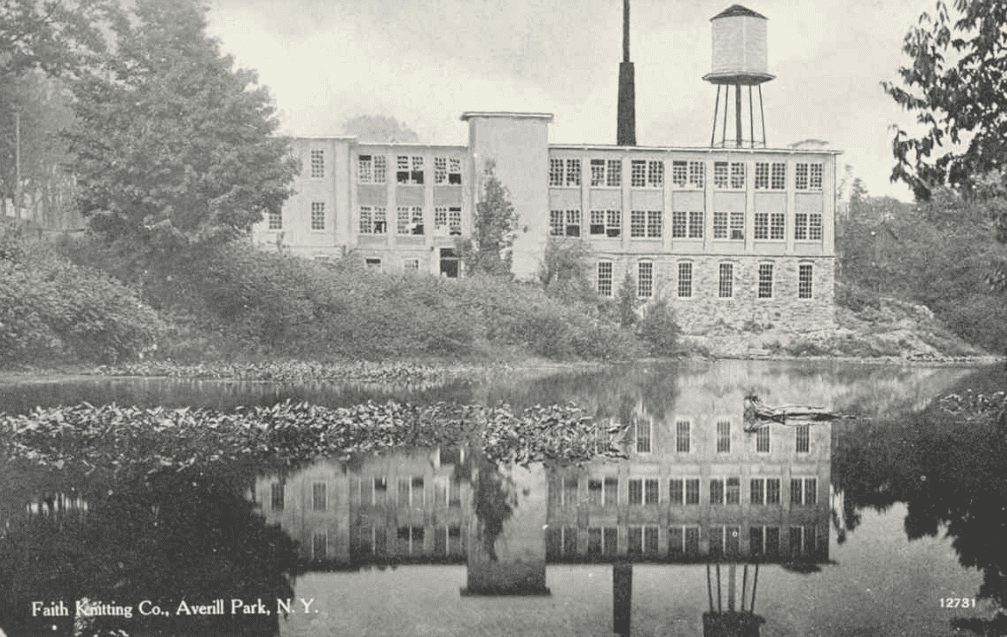
 In June I found myself in Averill Park, in Rensselaer County, NY, participating in a residency – spinning and weaving up a storm, but more on that later. First, I want to tell you about the mill where the residency is hosted, the Faith Mills.
In June I found myself in Averill Park, in Rensselaer County, NY, participating in a residency – spinning and weaving up a storm, but more on that later. First, I want to tell you about the mill where the residency is hosted, the Faith Mills.
The Faith Knitting company (they became Faith Mills Inc. in 1929) knitted wool and cotton “union-suits” (long underwear), shirts and drawers from 1897 through 1962.

 The mill was fully integrated, meaning 1,000 pound bales cotton and wool would arrive at the lower mill, and through the processes of mixing, carding, spinning, knitting, cutting, sewing and finishing, polished products came out. The mixing took place at the lower mill and the wool/cotton blends were then blown through pipes into bins in the upper mill.
The mill was fully integrated, meaning 1,000 pound bales cotton and wool would arrive at the lower mill, and through the processes of mixing, carding, spinning, knitting, cutting, sewing and finishing, polished products came out. The mixing took place at the lower mill and the wool/cotton blends were then blown through pipes into bins in the upper mill.
“The cloth was brought to the man who was called a cutter. He laid out fifteen thicknesses and pulled down an apparatus that cut through them all. The bundled pieces were then passed on to the sewing machine operators. Each worker had one job,” Grace Briscoe, who worked in mill for six months in 1900, recalled.
“The last step was for the finest seamstress who did all the buttons and button holes by hand. That was my job… The room must have been fifty feet long. It had no heat or electricity. There was drinking water provided, but no cups. I must have brought my own.”
In 1906 the mill burned to the ground after a fire started “in the picking room, which contained a large quantity of fluffy cotton. It spread rapidly through the entire building, burning it to the ground. Unfortunately, the plant steam driven fire pump was being repaired at the time and could not be used.”

 A new concrete building was constructed for the mill in 1908 which had a sprinkler system, a 40,000 gallon water tower, incandescent electric lights and a one cylinder steam engine to power the machinery, replacing the power of the Wynants Kill.
A new concrete building was constructed for the mill in 1908 which had a sprinkler system, a 40,000 gallon water tower, incandescent electric lights and a one cylinder steam engine to power the machinery, replacing the power of the Wynants Kill.
During the Second World War, Faith Mills developed a “new three-dimensional fabric” for the U.S. Navy with a waffle-knit technique that added “thousands of tiny air pockets” making it “the perfect insulator as it keeps heat out and cold in.”
They went on to supply wool and cotton knitted “merchandise to nearly all military branches of the Government” winning an Army-Navy E award “for high achievement in producing materials needed for war.”
After the war they continued manufacturing through owner William D. Mahoney’s death in 1951 and an acquisition in 1956 by Flagg-Utica Corp., an investment syndicate composed of first Albany Corp. and Victoria Investment Co., LTD of Nova Scotia. Eventually the mill closed as manufacturing moved South and for many years it was a box factory and largely abandoned.
In 2011 Arts, Letters and Numbers was founded. During my two-week residency I worked from a spot on the top floor of the mill, and slept in the old employee housing. You can read more about that experience and see more photos at my website Fiber in Vermont.
Michelle Krasny is a career coach and fiber artist.
Photos courtesy Sand Lake Historical Society.

